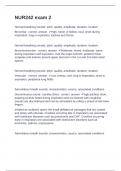NUR242 exam 2
Normal breathing sounds: pitch, quality, amplitude, duration, location
Bronchial - correct answer ✔High, harsh or hollow, loud, short during
inspiration, long in expiration, trachea and thorax
Normal breathing sounds: pitch, quality, amplitude, duration, location
Bronchovesicular - correct answer ✔Moderate, mixed, moderate, same
during inspiration and expiration, over the major bronchi- posterior btwn
scapulae and anterior around upper sternum in the 1st and 2nd intercostal
spaces
Normal breathing sounds: pitch, quality, amplitude, duration, location
Vesicular - correct answer ✔Low, breezy, soft, long in inspiration, short in
expiration, peripheral lung fields
Adventitious breath sounds: characteristics, source, associated conditions
Discontinuous sound: crackles (fine) - correct answer ✔high pitched, short,
popping sounds heard during inspiration and not cleared with coughing;
sounds are discontinued and can be stimulated by rolling a strand of hair btwn
fingers.
Inhaled air suddenly opens the small deflated air passages that are coated
and sticky with educate. Crackles occurring late in inspiration are associated
with restrictive diseases such as pneumonia and CHF. Crackles occurring
early in inspiration are associated with obstructive disorders such as
bronchitis, asthma, emphysema
Adventitious breath sounds: characteristics, source, associated conditions
, Discontinuous sound: Crackles (course) - correct answer ✔low pitched,
bubbling, moist sounds that may persist from early inspiration to early
expiration, also described as softly separating velcro.
Inhaled air comes into contact with secretion in large bronchi and trachea.
May indicate pneumonia, pulmonary edema and fibrosis. "velcro rates" of
pulmonary fibrosis are heard louder and closer to stethoscope, usually do not
change location- all more common in clients with long term COPD
Adventitious breath sounds: characteristics, source, associated conditions
Continuous sound: Pleural friction rub - correct answer ✔low pitched, dry
grating sound, like crackles but occurs more superficial and during both
inspiration and expiration.
Sound is the result of rubbing of 2 inflamed pleural surfaces.
Pleuritis
Adventitious breath sounds: characteristics, source, associated conditions
Continuous sound: Wheeze (sibilant) - correct answer ✔high pitched musical
sounds heard primarily during expiration but also may be heard on inspiration.
Air passes through constricted passages (caused by swelling, secretions, or
tumor)
Sibilant wheezes often heard in cases of acute asthma or chronic emphysema
Adventitious breath sounds: characteristics, source, associated conditions
Continuous sound: Wheeze (sonorous) - correct answer ✔Low pitched
snoring or moaning sounds heard primarily during expiration but may be
heard throughout respiratory cycle, may clear with coughing.
Same as sibilant wheeze. The pitch of the wheeze cannot be correlated to the
size of the passageway that generate it.





